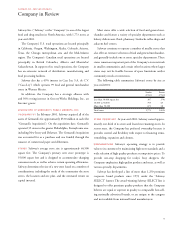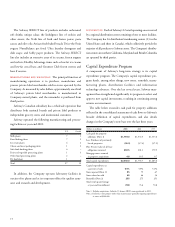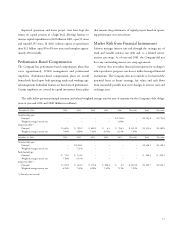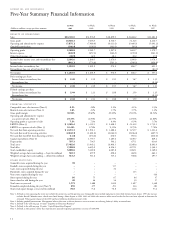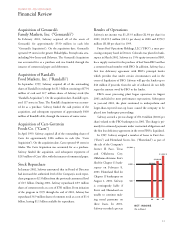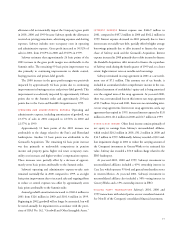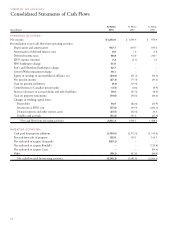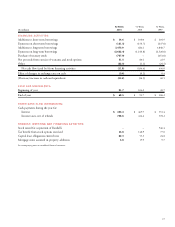Safeway 2001 Annual Report Download - page 20
Download and view the complete annual report
Please find page 20 of the 2001 Safeway annual report below. You can navigate through the pages in the report by either clicking on the pages listed below, or by using the keyword search tool below to find specific information within the annual report.
18
New Accounting Standards
In June 2001, the Financial Accounting Standards Board issued
SFAS No. 141, “Business Combinations,” and SFAS No.142. SFAS
No. 141 requires that all business combinations initiated after June
30, 2001 be accounted for under the purchase method and address-
es the initial recognition and measurement of goodwill and other
intangible assets acquired in a business combination. In the event
Safeway acquires goodwill in the future it will not be amortized.
SFAS No. 142 addresses the initial recognition and measurement of
intangible assets acquired outside of a business combination and the
accounting for goodwill and other intangible assets subsequent to
their acquisition. SFAS No. 142 provides that intangible assets with
finite useful lives be amortized and that goodwill and intangible
assets with indefinite lives will not be amortized, but will rather be
tested at least annually for impairment. Under the provisions of
SFAS No. 142, any impairment loss identified upon adoption of
this standard is recognized as a cumulative effect of a change in
accounting principle. Any impairment loss incurred subsequent to
initial adoption of SFAS No. 142 is recorded as a charge to current
period earnings. SFAS No. 142 was effective for Safeway beginning
on December 30, 2001 and, since that time, Safeway has stopped
amortizing goodwill. Goodwill was $5.1 billion at year-end 2001
and $4.7 billion at year-end 2000. Goodwill amortization was
$140.4 million in 2001, $126.2 million in 2000 and $101.4 mil-
lion in 1999. Other than the elimination of goodwill amortization,
the Company has not yet determined the effect that adoption of
SFAS No. 142 will have on its financial statements.
In October 2001, the Financial Accounting Standards Board
issued SFAS No. 144, “Accounting for the Impairment or
Disposal of Long-Lived Assets.” SFAS No. 144, which replaces
SFAS No. 121 and APB No. 30, became effective for Safeway on
December 30, 2001. Adoption of this standard did not have a
material effect on the Company’s financial statements.
Emerging Issues Task Force (“EITF”) Issue Nos. 00-14,
“Accounting for Certain Sales Incentives;” 00-22, “Accounting for
‘Points’ and Other Time-Based or Volume-Based Sales and
Incentive Offers, and Offers for Free Products or Services to be
Delivered in the Future;” and 00-25, “Vendor Income Statement
Characterization of Consideration from a Vendor to a Retailer”
became effective for Safeway beginning in the first quarter of 2002.
These Issues address the appropriate accounting for certain vendor
contracts and loyalty programs. Adoption of these issues did not
have a material effect on the Company’s financial statements.
Forward-Looking Statements
This Annual Report contains certain forward-looking statements
within the meaning of Section 27A of the Securities Act of 1933 and
Section 21E of the Securities Exchange Act of 1934. Such state-
ments relate to, among other things, capital expenditures, acquisi-
tions, the valuation of Safeway’s investment in GroceryWorks,
operating improvements and costs and gross profit improvement
and are indicated by words or phrases such as “continuing,” “on-
going,” “expects,” and similar words or phrases. The following are
among the principal factors that could cause actual results to differ
materially from the forward-looking statements: general business
and economic conditions in our operating regions, including the
rate of inflation, consumer spending levels, population, employ-
ment and job growth in our markets; pricing pressures and com-
petitive factors, which could include pricing strategies, store
openings and remodels by our competitors; results of our programs
to control or reduce costs, improve buying practices and control
shrink; results of our programs to increase sales, including private-
label sales, and our promotional programs; results of our programs
to improve capital management; the ability to integrate any compa-
nies we acquire and achieve operating improvements at those com-
panies; changes in financial performance of GroceryWorks or our
other equity investments; increases in labor costs and relations with
union bargaining units representing our employees or employees of
third-party operators of our distribution centers; changes in state or
federal legislation or regulation; the cost and stability of power
sources; opportunities or acquisitions that we pursue; the rate of
return on our pension assets; and the availability and terms of
financing. Consequently, actual events and results may vary signifi-
cantly from those included in or contemplated or implied by such
statements. The Company undertakes no obligation to update for-
ward-looking statements to reflect developments or information
obtained after the date hereof and disclaims any obligation to do so.



